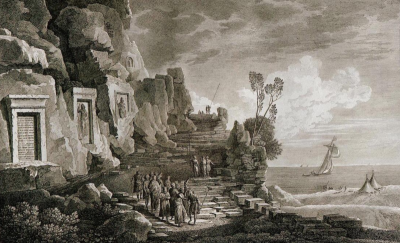Excavators have been in operation since August at the Nahr el-Kalb site. Photo P.H.B.
This clear historical and environmental desecration is the result of authorization granted to the FPM by the former Minister of Culture, Ghattas Khoury. Rented on a long-term basis by the Maronite wakf, for a few months the exposed site has been home to the deafening noises of bulldozers and excavators. According to May Khoreiche, vice-president of the FPM, the construction will have "no negative impact on the site". "The preliminary studies of the construction operations have been approved by the General Planning Directorate as well as the relevant authorities. Proof of this is the approved construction permit", she told L'Orient-Le Jour. However, in 2003, the General Directorate of Antiquities (GDA), which was unable –due to its limited means– to purchase the surrounding land, had declared the area a non-buildable zone (non aedificandi). Moreover, the historical site of Nahr el-Kalb was classified by decrees N ° 166 / LR, of November 1933, and N ° 225 of September 28, 1934 and placed on the national list of historical monuments. In 2005, it was listed in the UNESCO Memory of the World register.
A definite impact
According to Jad Tabet, president of the Order of Engineers and Architects, the project "will certainly have an impact", contrary to what its promoters are saying. According to him, the project, which was presented to the Higher Council for Urban Planning two years ago, was located on ground much closer to the historical ruins. The GDA refused the permit, insisting that it be placed further away, behind the hill. However, the buildings will remain visible from Jounieh.
Asked by L’OLJ to comment on the project, the vice-president of the Kataeb party, Salim Sayegh, supported the idea of having "an investigation committee that will prove if there is a real risk of damage to this historical heritage". But according to him, "there is no doubt that there will be". Mr. Sayegh asked for "an immediate freezing of the project until a serious study regarding its ecological impact" is established.
Witnesses to history
The site is home to writing, images and iconography engraved onto the stone steles, which are of crucial importance to the heritage, and to the history of Lebanon. It includes 22 steles, historical reliefs, and commemorative inscriptions dating from the 2nd millennium BC (the 13th century BC) to the 2nd millennium AD (20th century AD).
In 2003, a restoration of the site -funded by the National Heritage Foundation-, was carried out. The work included cleaning the steles, laying down the foot paths, closing part of the site, and putting up road signs as well as descriptions of the various artifacts.
On a strategic promontory that separates the Metn from Keserwan, and alongside the Nahr el-Kalb river, the source of which originates in the Jeita grottos, the steles -located 15 kilometers north of Beirut-, are witnesses to major events that have impacted the region, from Antiquity to the present day. It seems that every conqueror who passed through Lebanon insisted on leaving behind signs of their passage. Notably there are inscriptions from the Egyptian Pharaonic, Assyrian, Babylonian, Hittite, Greek, Roman, Arab, French and British eras, including one left by the Lebanese themselves (in the year 2000 and marking the withdrawal of the Israeli army).
The site’s historic value is priceless, although some of the weather-worn steles have become indecipherable. Three Egyptian reliefs from the 13th century BC, including that of the pharaoh Ramses II, paint a picture of the Levant’s geopolitical situation during the second millennium BC. Five Assyrian reliefs display the expansionist policy of the Assyrian kings which brought them to the shores of the Mediterranean, including that of the Assyrian sovereign Esarhaddon, and of Nebuchadnezzar II (a Neo-Babylonian). There is also an inscription left by the Roman emperor Caracalla (211-217 AD), and another from the Mamluk period attributed to Sultan Barquq (1382-1399). Inscriptions commemorating events between 1860 and 2000, such as one bearing the name of General Henri Gouraud (July 25, 1920), are found nearby.
In addition to the various steles and inscriptions, other historical and archaeological remains include elements found in the Nahr el-Kalb valley: for example, the bridge built by the Mamluk sultan Saif el-Din Barquq. Its latest restoration dates back to the time of Emir Shehab II (1809). Unfortunately, today it is privately owned, and serves as the entrance to a restaurant!
On Monday, after denouncing a “programmed campaign”, and the spreading of “rumors” against it, the FPM’s press office claimed to have obtained all the necessary approvals and permits from the relevant authorities, including the ministries of Culture and Environment, the Higher council for urban planning, the Order of Engineers, and the Metn Union of Municipalities. The party claims to have obtained these authorizations “within the framework of the law, before starting the construction work”.
“The excavation work allowing the expansion of the construction area has been completed for a while now, and it has not spoiled the archeological and historical site. No damage has been recorded”, added the FPM. Finally, the party clarified that it has planned to increase the distance between the complex and the historical site by an additional 20 meters.
(This article was originally published in French in L'Orient-Le Jour on the 17th of February)
